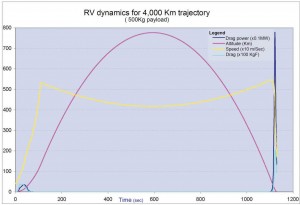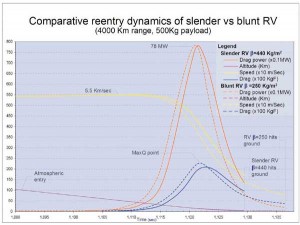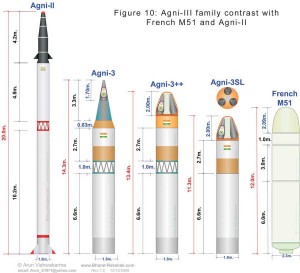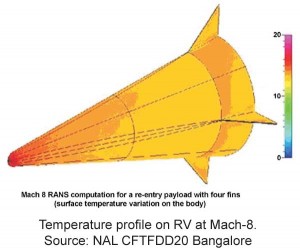As the missile descends further the atmosphere density increases and the drag rapidly rises, also a very strong shockwave builds at the leading edge increasing the local tip temperature well beyond 3,000º C.
 Tremendous dynamic pressure builds along the RV body creating drag that dissipates kinetic energy at the rate of 30 – 220 megawatt.
Tremendous dynamic pressure builds along the RV body creating drag that dissipates kinetic energy at the rate of 30 – 220 megawatt.
Eventually the RV enters ‘MaxQ’ point where the dynamic pressure is maximum. This combination of extremely high temperature and dynamic pressure can easily wreck anything but a most carefully engineered system using a combination of exotic material and manufacturing process.
Agni-TD (Technology Demonstrator)
The Agni-TD’s RV-Mk.1 nose tip is made of a multi-directionally woven, reinforced carbon-carbon fiber composite material. The 0.8 metre diameter (1.0 m flare skirt) and ~4 metre long, reentry vehicle consists of five sections. Each of these sections is made up of a two-layer composite construction. The inner layer is made up of carbon/epoxy filament mould constructed on a CNC winding machine and is designed to withstand structural loads. The outer layer is ablative and made of carbon/phenolic filament wound construction.
 This 1980-circa RV (Figure 8-C) was designed to carry BARC-developed 1980 circa, boosted nuclear weapon of 200 kT yield weighing ~1,000 kg (Figure 3, Figure 8-A). The 80 cm body diameter is determined by the diameter of the boosted fission weapon. RV’s blunt nose tip of 30 cm spherical diameter and 14.3º cone angle indicates use of moderately high beta (²)14 design for ICBM class high reentry velocity yet modest temperature stress (3,000°C). The 1,000 kg RV sees peak power dissipation in excess of 120 megawatts (Figure 7: Effect of ‘²’ on RV stress).
This 1980-circa RV (Figure 8-C) was designed to carry BARC-developed 1980 circa, boosted nuclear weapon of 200 kT yield weighing ~1,000 kg (Figure 3, Figure 8-A). The 80 cm body diameter is determined by the diameter of the boosted fission weapon. RV’s blunt nose tip of 30 cm spherical diameter and 14.3º cone angle indicates use of moderately high beta (²)14 design for ICBM class high reentry velocity yet modest temperature stress (3,000°C). The 1,000 kg RV sees peak power dissipation in excess of 120 megawatts (Figure 7: Effect of ‘²’ on RV stress).
Agni-TD was first launched on 22 May, 1989 to prove the RV-Mk.1. The re-entry vehicle was designed to ensure that the temperature inside the vehicle does not exceed 60° celsius, a condition necessary to protect the warhead and electronic systems placed inside. During tests, the re-entry vehicle technology was fully proved when the nose-cone withstood temperatures of 3,000°C while the inside temperature was only 30°C15. It is important to note that re-entry temperature peak is independent of the payload weight. Thus the Agni-TD with the RV fitted with a high altitude motor could achieve necessary test velocity, to fully qualify the re-entry regime.
The RV housed an integrated High Altitude Motor (HAM). The liquid fuelled HAM is used to correct impulse variance of solid fuelled stages and subtle launch trajectory variance; approximately 50 to 80 kg fuel is estimated to be sufficient. There are indications that the RV is intended to enter a gliding trajectory when it enters atmosphere at an altitude of 100 km, this further reduces thermal stress.
Arrival of Modern Thermonuclear Weapon: Pokhran-II
In response to changed security environmentIndia conducted Shakti series of nuclear weapon tests16 on 11 & 13 May, 1998. Shakti-1 (Figure 8-A) was a two stage Thermonuclear (TN) bomb (of modern 1995 design vintage) with a passive third stage made of non-fissionable material. It should be noted that in a Thermonuclear weapon the third stage provides around 80% of the yield from fast fission of U238 by fast neutrons generated by fusion stage17.
Fast fission of U238 (or U235) is a basic material property that does not require testing in weaponised configuration. Shakti-1 did not have a third stage to keep the yield within test-shaft capability (venting) and test site constrains (seismic damage to inhabited villages nearby). The Shakti-1 based Indian TN weapon yield is 200-300 Kt depending on if tamper and case material is made of natural-uranium (U238) or enriched-uranium18. The new 200 Kt TN weapon (Figure 3-B) is much lighter than the earlier 1,000 Kg Boosted Fission weapon (Figure 3-A) that was the basis for earlier RV-Mk.1 design. Fission weapons are dense and spherical in shape, whereas TN weapons have lower density and elongated in shape yet very high yield to weight ratio. The 200 Kt yield TN weapon reportedly weighs less than 450 Kg, however other sources indicate less than 300 Kg weight, yet few other sources indicate a figure as low as 200 Kg19.
Interestingly the 200 Kt boosted fission design that was the basis for Agni-TD and RV-Mk.1 design was not even tested in Shakti-series of nuclear weapon tests in 1998. For best performance the 200 Kt TN payload requires its own custom RV design and rocket stages but that would have to wait for many years.
The 1999 ‘Kargil war’ forced DRDO to improvise and quickly develop and operationalise Agni-II missile that used the new light weight TN weapon albeit using the old RV-Mk.1 that was designed and optimised for heavier 1,000 Kg boosted fission payload. This can be deduced from the pictures of the Agni-II & Agni-I released by DRDO.
Agni-II and Agni-I Maneuvering Re-entry Vehicle: MRV-Mk.2
This RV largely inherits the basic structure, design and technology of the earlier Mk.1 RV of the Agni-TD, but has more functionality and superior performance. After making room for new and lighter Indian thermonuclear weapon payload, the RV has room for about 200 kg liquid fuel in pressurised vessels to serve as High Altitude Motor for propulsion, as well as velocity correction.
It is interesting to note that long-range missiles developed by other countries use RVs that are passive ballistic mass, thus their accuracy depends on ability of missiles RV-bus to place RV on precise ballistic trajectory. The Agni-RV Mk.2 on the other hand, is more advanced because it embodies propulsion, navigation and control all the way to the target.
At least one variant uses a set of solid fuelled impulse cartridges for velocity trimming. The less than perfect mating of lightweight TN weapon an RV designed for heavier 1,000 Kg payload imposed its own challenges (different CG and lowered ‘²’ due to lighter payload) that also required addition of aero-fins.
The lowered ‘²’ more rapidly slows the RV makes it susceptible to atmospheric disturbances and interception. On the other hand, reduced payload mass significantly increased the missile velocity & range (see range graph in Figure 2).
The RV has an attitude control system and aerodynamic maneuver fins, for better control, accuracy and survivability. Unconfirmed reports suggest that an improved optical or radar terminal phase correlation system has been developed to provide accuracy of around 40 metres CEP.
It is interesting to note that long-range missiles developed by other countries use RVs that are passive ballistic mass, thus their accuracy depends on ability of missile’s RV-bus to place RV on precise ballistic trajectory. The Agni-RV Mk.2 on the other hand, is more advanced because it embodies propulsion, navigation and control all the way to the target.
Recent ICBM Developments
Last few months saw maiden test flights of two new generation ICBMs. The Indian Agni-III (9 July, 2006) and the French M51 (9 Nov, 2006) made by DRDO and EADS-SPACE respectively.
 The M51 is a 3 stage missile that is 12m long and 2.3m diameter (Figure 10). All 3 stages have flex nozzle (for thrust vectoring) and the case made of wound carbon-epoxy fiber composite21 to maximise the fuel mass fraction such that the missile can fit into the missile launch tube of French SNLE nuclear powered ballistic missile submarine carrying the M41 missile, yet it carries 50% more fuel to provide 50% more payload and 50% more range.
The M51 is a 3 stage missile that is 12m long and 2.3m diameter (Figure 10). All 3 stages have flex nozzle (for thrust vectoring) and the case made of wound carbon-epoxy fiber composite21 to maximise the fuel mass fraction such that the missile can fit into the missile launch tube of French SNLE nuclear powered ballistic missile submarine carrying the M41 missile, yet it carries 50% more fuel to provide 50% more payload and 50% more range.
The solid fuel motors are very heavily packed to carry the additional fuel mass (almost 85% of available internal volume). The 56 tonnes missile’s declared range is 8000 km for 6 MIRV payloads and penetration aids totaling 1,400 kg. Yet the same missile delivers high ICBM range (16,000 km) for a configuration with fewer (2) MIRVs thus providing flexibility to France nuclear doctrine.
DRDO’s Agni-III is a 2 stage missile that is 14.3m long and 1.8 metre22 diameter (Figure 10). Both stages have flex nozzle for optimal flight and trajectory control. The motor case are made of wound carbon fiber composite material23 for high fuel mass fraction that is necessary for a small but long range missile. The first and second stages are about 6.6 metres and 2.7 metres long with a 1 metre vented inter-stage24.
The missile supports a wide range of warhead configurations, with total payload ranging from 600 kg to 1,800 kg. The missile is compact and small enough for easy mobility and flexible deployment on different types of surface and sub-surface platforms. The diameter is compatible with a recently tested Indian sub-surface launch system with 2.4 metre diameter launch tube25. The Agni-III is clearly a precursor to a submarine launched version (Agni-3SL in Figure 10).
Agni-III Re-entry Vehicle Options
Finally, the suboptimal RV gave way to a new RV custom designed & optimised for the newer and lighter 200 Kt TN payload weapon and capable of very high speed reentry. The RV-Mk.4 (Figure 8-E & F) (estimated from news reports, analysis and trade practices) has the following significant features:
 An all carbon composite RV that uses no metal backup (world’s first)26. This light and tough RV enables large increase in range for light payload.
An all carbon composite RV that uses no metal backup (world’s first)26. This light and tough RV enables large increase in range for light payload.
The high ‘²’ ( ² = m * CD / A ) RV design with 17 cm diameter blunt nose27 to generate a separating shock wave to keep the thermal flux away from the RV body.
The RV is 1.7 metre long and cone angle of 20° with maximum body diameter of approx 0.6m. Thus the effective body area is at least half that of RV Mk-2. The ‘²’ is high in spite of lighter mass.






Is making a deal of Dassault Rafale by the IAF be going to be of any use in coming task , beacause most of the nations that are posing a threat on India are making even advanced fighter air-crafts ( like J-20 by CHINA).As the time is passing by, the deal is getting even costlier (and meaningless)? Although these air-crafts are going to complement the proposed FGFA and AMCA air-crafts, still spending that amount of money on such a plan that cannot prove to be decisive in a war in out of clue to understand.And at this time when India needs these fighter planes (right now), the deal is still under consideration and all the responsibility of defending Indian skies lies directly on Su-30 MKI (& also on old MIG-29 flanker). http://www.techinvicto.com/
Deterrence is necessary to zero out a resolute enemy’s thought of complete annihilation.
At the same time conventional weapons are to punish enemy in sub-nuclear engagement. Tejas is seed of our IAF backbone. SU30MKI is expensive to operate & maintain. Albeit good aircraft.
-Arun S Vishwakarma
Sir,
You wrote an eye opening article & gave us the clear view about our choice of materials as well as principles we are adopting to built nuclear weapons and missiles. I read lot of articles full with irrelevant content they were merely stories.
Namastey,
Glad to know you like it.
I encourage you (and all readers) to contribute materially to serve Bharat Maata in substantial ways.
Jai Bharat
-Arun S Vishwakarma
Sir,i have read yours articles time and again they give me immense confidence and at the same time reverence for you i have tried to look for an autopsy by you of Pak nuclear arsenal but have not found it could you please write a artic le about them
Namastey,
Happy to know you like it.
Please serve Bharat Maata in substantial ways.
Paki weapons are inconsequential. So I wont spend time on their nuke facade.
Here is a accurate rendering of their nukes, made by a friend of mine many years ago. Funny but accurate .
Photochor: AQ Khan
https://www.youtube.com/watch?v=wciSG_3-x28
Jai Bharat
-Arun S Vishwakarma
Read more at:
https://www.indiandefencereview.com/spotlights/indias-strategic-missiles/